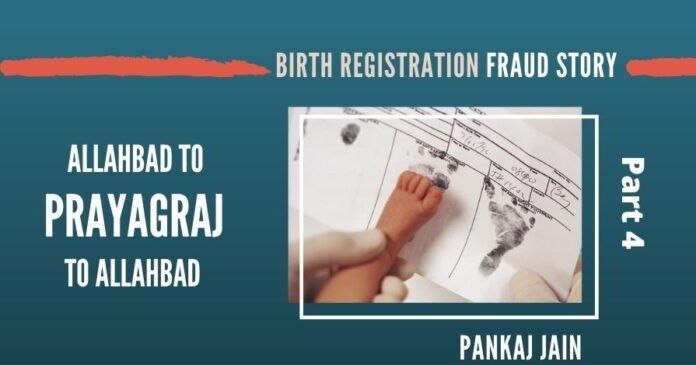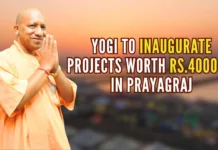
The first episode of this series covered background information on how the loopholes in the birth registration system are exploited in our country. The second episode presented some data on the scale of this fraud, especially in Prayagraj. In the third episode, we dived deep into a specific example of birth registration fraud done by Mohd. Azam Khan and his family. In this episode, we will show how the fraudulent birth registration racket in Prayagraj has become hyperactive since the advent of the Citizenship Amendment Act (CAA).
The author recently stumbled upon a couple of news stories on how the number of birth registrations had skyAllahabad rocketed in Bareilly since the advent of CAA – [1] [2]
As per these stories from Bareilly, not only have the number of birth registrations gone up many folds but also the percentage of applicants from a particular minority community has shot up dramatically. So we decided to check how the situation in Prayagraj has changed after the CAA. The change is staggering and is captured in the table below. Let us remind the readers that we are looking at new birth registration data and not the request for issue of birth certificates (against an existing birth registration).
 In the above table, we have compared the birth registration data for two dates 28.08.2018 (prior to CAA and also covered in Part 2 of this series) and 10.01.2020 (post CAA). We guessed the community by looking at the name of the ‘child’ and the parents – though the religion of the child is part of the registration data, it has not been exposed online.
In the above table, we have compared the birth registration data for two dates 28.08.2018 (prior to CAA and also covered in Part 2 of this series) and 10.01.2020 (post CAA). We guessed the community by looking at the name of the ‘child’ and the parents – though the religion of the child is part of the registration data, it has not been exposed online.
The municipal authorities and the police took some action against the racket in Bareilly, the corresponding authorities in Prayagraj have turned a blind eye, even though the racket in Prayagraj is far more sinister.
Here are the key observations:
- The number of registrations per day has blown up by 2.5 (two and a half) times, from 85 to 213.
- What is even more striking is that the number of registrations of the minority community is 6 times what it was prior to CAA – i.e. from 14 to 85. The registrations statistic from the majority community has had a very modest growth – 1.8 times, i.e. 80% growth.
- Interestingly, the percentage of minority community registrations has gone up from 16% to 40%. As per the 2011 census data, the minority community comprises about 20% of the Prayagraj’s population.
- As we saw in part 1 and 2, the birth registrations done within 21 days of birth are very likely to be genuine, whereas birth registrations are done after a gap of 1 year or more are likely to be fraudulent. This is a reasonable assumption for Prayagraj, as a birth registration after more than 1 year of birth can only be done on an order of the SDM (Sub-Divisional Magistrate), and the SDM can only issue such an order after verifying the truthfulness of birth. But as the author has found (and explained in Part 2) that, in Prayagraj, such SDM orders are being issued without any verification, thereby allowing fraudulent birth registrations in large numbers. Further, as per the law, such delayed birth registrations without verification are illegal and to be treated null and void. If we look at the stats in the table above, it is crystal clear that only 7% birth registrations of the minority community have been done within 21 days and are likely to be genuine, whereas a whopping 79% birth registrations of the minority community have been done after a delay of more than 1 year, and therefore are likely to be fraudulent.
- The average lag for registration of the minority community is 7.25 years, which is remarkably higher than that of the majority community (3.34 years).
- Another indicator for the genuineness of the birth registration is the place of birth – birth registrations with a place of birth as the hospital are very likely to be genuine, whereas those reported to be at home are very likely to be dicey. 75% of the births in the minority community have been reported to be at home – highly improbable as Prayagraj has a decent medical infrastructure and which is equally accessible to people from all communities.
- There were some bizarre registrations from the minority community where multiple registrations were done by the same parents and the gap between the birth dates of the children was inordinately low – for example, a couple got three registrations done on 10.01.2020, wherein the gap between the birth of two children was about 2 months, and even though the address was the same, the wards for registration were different!
The situation in Prayagraj is different and more dangerous than that reported in Bareilly on two counts. Firstly, while in Bareilly, it was a case of printing forged birth certificates (and therefore it is easy to find that they are forged), in Prayagraj it is a case of fraudulent birth registrations. Once such fraudulent registrations are entered into the birth register and birth certificates are issued against such registrations, it will be next to impossible for anyone to discover them to be fraudulent.
Secondly, while the municipal authorities and the police took some action against the racket in Bareilly, the corresponding authorities in Prayagraj have turned a blind eye, even though the racket in Prayagraj is far more sinister. The author has been chasing the Prayagraj Nagar Nigam officials for over two years now, but they have not taken any action and have let this racket prosper. In fact, one of the officials that the author has written to is Mr Uttam Kumar Verma (the Registrar) who has signed all the birth certificates that were issued on 10.01.2020. These officials are aware of the scale and the modus operandi of this racket, and they have also been provided with evidence of how people from other parts of the country, including some doctors, are involved in this racket, but they have merely swept it under the carpet. The Prayagraj police have also been lackadaisical in this matter, and have either just transferred the complaint or closed the matter after a shoddy investigation. Even complaints to the Chief Minister’s office have not borne any results, and the DM and SDMs don’t seem to be bothered at all.
However, there is no doubt that this racket is thriving in Prayagraj and has gone into an overdrive post CAA, possibly with the active support of the municipal and law enforcement authorities. Also, this is extremely dangerous, as this could artificially alter the demographics of Prayagraj, which could culminate into communal tension.
References:
[1] After CAA, rise in number of applications for birth certificates, some locals get fake docus – Feb 15, 2020, The Times Of India
[2] Bareilly police bust fake birth certificate racket – Jan 09, 2020, Hindustan Times
- Allahabad to Prayagraj to Allahabad - September 4, 2020
- The Curious Case of Azam Khan’s Hindu son - August 18, 2020
- The AllahaBAD born identity - August 12, 2020











Weird things happening
This calls for an CBI probe. We need the CBI to look into not only how someone died in mumbai but also how someone was ‘born’ in prayagraj.
Why such of dangerous manipulations & exploitations in connivance with the babu’s are not rectified at the threshold by the concerned Central Authorities. 🤔
OMG.
Medical Miracles happens in Prayagraj
😂😂